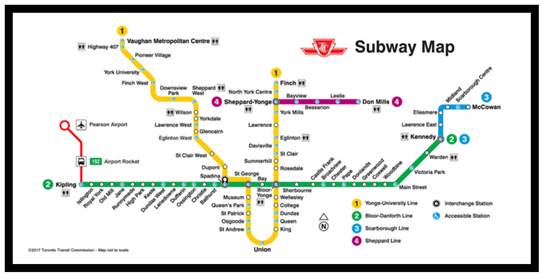
Transit update, Toronto and Ottawa
RailwayAge.com
Oct. 2, 2017
John Thompson
Toronto’s Spadina Subway extension is scheduled to open for service in December, and the Canadian government’s transfer of funds from the proposed Sheppard East LRT to the approved Finch West LRT line may cancel the former. Meanwhile, Ottawa’s Confederation and Trillium LRT lines have been awarded C$3.6 billion for expansion.
The 5.3-mile Spadina Subway extension (also known as the Vaughan Extension) will open for service on Sunday, Dec. 17, 2017. It extends from Sheppard West station, at the intersection of Dufferin Street and Sheppard Avenue West, to the Vaughan Metropolitan Corporate Centre, near Provincial Highway 7 and Jane Street West, in the adjoining City of Vaughan. The Centre includes a shopping mall and office complex; subway proximity is expected to stimulate expansion.
Work began on the project in February 2008. Progress was delayed by a fatal accident followed by a construction shutdown; project management issues; station redesigns; and other problems. The final cost is estimated to be approximately C$3.2 billion, divided among the governments of Toronto, York Region, Ontario, and Canada.
The Spadina extension is entirely underground. One of the main source of riders will be York University, which has its own station; there are five stations in total. At Finch West station, the subway will connect with the approved Finch West LRT line, scheduled to open in 2022. An underground station for the LRT has been “roughed in.”
The new subway represents the latest extension to the TTC’s original 4.35-mile Yonge Subway, opened in 1954. It has been extended incrementally: under University Avenue to Bloor Street, 1963; to Wilson Avenue, 1978; to Sheppard West, 1996. The designation “Spadina Subway" is, historically, somewhat inaccurate, as it is only located under Spadina Road for approximately one mile.
The line was originally intended to be built in conjunction with the Spadina Expressway project between Bloor Street and Highway 401, hence the name. However, although the expressway was cancelled by the Provincial Government in 1971, after massive protests by Toronto residents, the “Spadina” name was retained for the subway.
An announcement by the Canadian Government that it was transferring C$330 million from the proposed but unapproved Sheppard East LRT project to the approved Finch West LRT line would appear to sound the death knell for the former.
Sheppard East had been planned to extend approximately seven miles from the existing Don Mills terminal of the Sheppard rapid transit subway, to Morningside Avenue in northeastern Scarborough, a Toronto suburb. However, various Scarborough politicians had argued strongly against LRT technology over the years, preferring an eastward extension of the subway.
The five-station Sheppard Subway, opened in November 2002, extends four miles, from the Yonge Street Subway (Line One) to Don Mills Road, a major north-south artery. It is entirely underground, and was built at a cost of approximately C$800 million. The line was originally planned to extend several miles further east, but was cut back due to financing difficulties. It seems unlikely to be extended in the near future, as daily patronage is only approximately 45,000 riders, and other subway projects have greater priority.
Funding of C$3.6 billion for extensions to Ottawa’s Confederation LRT and Trillium DMU line has been approved. The City of Ottawa, the Government of Canada and the Government of Ontario will share the costs to a ceiling of $1 billion, with the Federal and Provincial governments sharing the remainder.
The project involves eastern and western extensions to the existing Crosstown project, due to open in 2018. Each extension will be about eight miles in length; they will bring LRT into the farther suburbs of Ottawa. The Trillium extension will take DMU service several miles further south, to Bowesville, with a branch to Ottawa International Airport. The Bowesville portion is being built on the right-of-way of Canadian Pacific’s abandoned Prescott Subdivision.
The Confederation LRT western extension will bring tracks to Moodie Road, where a storage and maintenance yard will be constructed. An additional nine stations are to be included. The line will be chiefly above ground, except for a section of tunnel between Dominion and Cleary stations, beneath the Sir John A. Macdonald Parkway. It will follow the existing Transitway (busway) immediately west from Tunney's Pasture station, which will be converted to rail operation.
The eastern extension, to Trim Road, features five new stations. Part of the alignment, which will be primarily surface, is to occupy the median of provincial highway 417. This road will require widening to accommodate the LRT. A total of 38 additional Alstom Citadis Spirit LRVs will serve the extensions, bringing the fleet to 72. Rideau Transit Group, the principal contractor on the current Confederation line, has received a C$106 million contract to expand the existing Belfast Road yard and shop, to accommodate the cars required for the eastern extension.
Finish work on the LRVs, which are assembled at Alstom’s Hornell, N.Y. plant, is done at Belfast. Rideau is not bidding on the LRT extensions. Construction work on those is scheduled to commence in 2019 and be finished by 2023.

